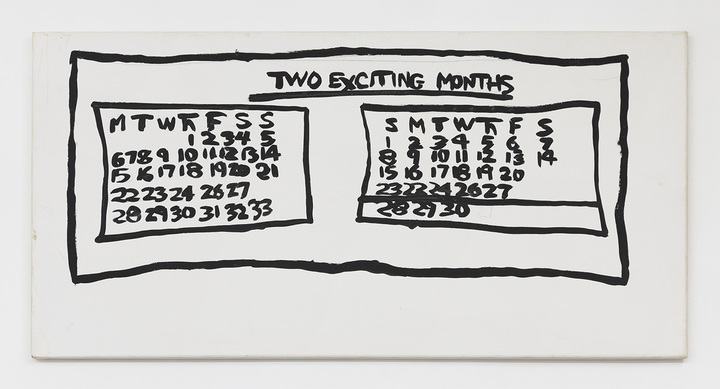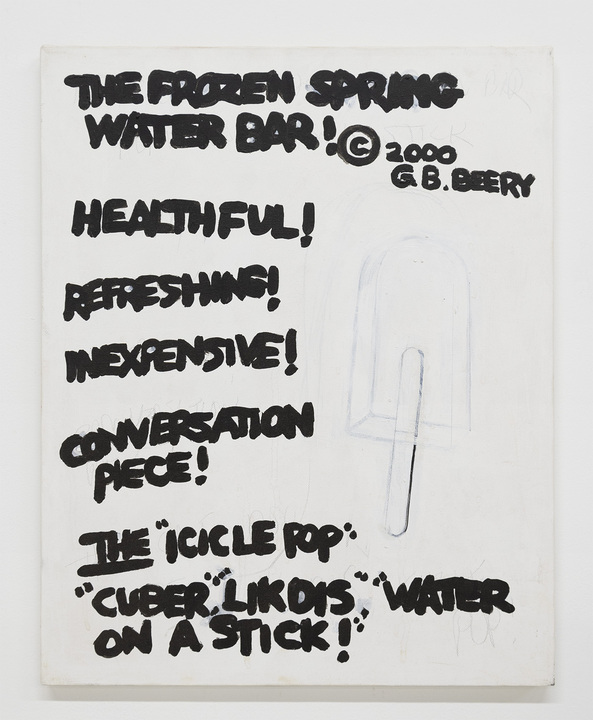Organized with Nick Irvin and Jordan Stein
Organized with Nick Irvin and Jordan Stein
Organized with Nick Irvin and Jordan Stein













Sanctuary, 2000s
Digital video, sound
2:00 minutes
Your Move, 2000s
Digital video, sound
2:05 minutes
Burning Cardboard, 2000s
Digital video, sound
2:03 minutes

The Shamrock Ranch To Dos, 1993
Acrylic on canvas
20 x 16 in (50.8 x 40.6 cm)

Family Portrait, 1970s
Acrylic on canvas
4 panels, each 20 x 20 in
overall dimensions 20 x 86 in

The Worlds Greatest Nonperforming Arrythmic Percussionist, 2000s
Acrylic and graphite on canvas
16 x 20 in (40.6 x 50.8 cm)

7 Felicitations, 1970s
Acrylic on canvas
20 x 26 in (50.8 x 66 cm)

Formal Portrait, 2000s
Acrylic and graphite on canvas
12 x 16 in (30.5 x 40.6 cm)

The Ethical Crisis Playoffs, 1970s
Acrylic on canvas
27 x 42 in (68.6 x 106.7 cm)

What Is the Formula?, 2000s
Acrylic on canvas
20 x 16 in (50.8 x 40.6 cm)

Unknown Unknowns, 2010
Acrylic and graphite on canvas
16 x 20 in (40.6 x 50.8 cm)

The Distractor, 2000s
Acrylic on canvas
16 x 12 in (40.6 x 30.5 cm)

Parenthood Art, 1970s
Acrylic on canvas
50 x 8 in (127 x 20.3 cm)

I've Seen the Graveyard, 2000
Acrylic and graphite on canvas
20 x 16 in (50.8 x 40.6 cm)

Hello! Bacteria Farm!, 2000s
Acrylic and graphite on canvas
16 x 20 in (40.6 x 50.8 cm)

I'm Only Interested in This!, 1999
Acrylic and graphite on canvas
14 x 11 in (35.6 x 27.9 cm)

The Master Speaks, 1970s
Acrylic on canvas
26.25 x 22 in (66.7 x 55.9 cm)

My Life Is Now Too Short to Spend Much Time on Formal Painting Art Concerns, 2000s
Acrylic and graphite on canvas
24 x 18 in (61 x 45.7 cm)

The Burden of Vulnerable Beauty, 2000s
Acrylic on cardboard
44 x 36 in (111.8 x 91.4 cm)

Art Continues to Create Artists, 2010
Graphite on canvas
14 x 11 in (35.6 x 27.9 cm)

No More Spectrum Credit, 1970s
Acrylic on canvas
30 x 36 in (76.2 x 91.4 cm)

"Hurling" World Tour, 2005
Acrylic on canvas
20 x 16 in (50.8 x 40.6 cm)

Important American Art Museums, 1970s
Acrylic on canvas
24 x 27.5 in (61 x 69.9 cm)

A Nice Painting, 1994
Acrylic on canvas
20 x 16 in (50.8 x 40.6 cm)

How I Worried About Life and Art All the Way Through Them and Everything Turned out All Right Anyway, 1990s
Acrylic on canvas
13.5 x 16 in (34.3 x 40.6 cm)

Quixotic, 1975
Acrylic on canvas
36 x 25.5 in (91.4 x 64.8 cm)

An Art Movement's Recipe for Universal Acceptance, 1999
Acrylic and graphite on canvas
24 x 18 in (61 x 45.7 cm)

No Campy Goading Here, 1990
Acrylic on canvas
18 x 14.25 in (45.7 x 36.2 cm)

Gift, 2012
Acrylic and graphite on canvas
14 x 18 in (35.6 x 45.7 cm)

A Chant to Counter Technological Excess, 1990s
Acrylic and graphite on canvas
25 x 22 in (63.5 x 55.9 cm)

Shopping List, 2018
Acrylic on canvas
36 x 24 in (91.4 x 61 cm)

A Magical Cure All Device, 2007
Acrylic and graphite on canvas
20 x 16 in (50.8 x 40.6 cm)

Mere Inheritors, 2000s
Acrylic and graphite on canvas
20 x 16 in (50.8 x 40.6 cm)

Zip! Zap! You Are Extinct Mr. and Mrs. Birdy, 2013–2016
Acrylic and graphite on canvas
18 x 14 in (45.7 x 35.6 cm)

Frat’rnal Regalia, 1970s
Acrylic on canvas
11 x 20 in (27.9 x 50.8 cm)

Two Exciting Months, 2000s
Acrylic and graphite on canvas
18 x 36 in (45.7 x 91.4 cm)

The Frozen Spring Water Bar!, 2000
Acrylic and graphite on canvas
20 x 16 in (50.8 x 40.6 cm)

Poeticize Life Happy Trails!, 2000s
Acrylic and graphite on canvas
20 x 16 in (50.8 x 40.6 cm)
Gene Beery (b. 1937, Racine, Wisconsin) is a critically important conceptual artist based in Sutter Creek, California. His singular, eccentric practice—first developed in the late 1950s in New York–presaged much of the language-based explorations of the second half of the 20th century.
For two years, Beery worked as a security guard at the Museum of Modern Art, where “some of the Cezanne pictures, if you watched them long enough, they'd move.” At the museum he also encountered a young night clerk called Sol LeWitt, who would later become his most loyal patron and collector. After fielding praise from Max Ernst, securing an award from the William and Norma Copley Foundation, and realizing an exhibition at the important Alexander Iolas Gallery, he left New York for Northern California in 1963. “I used to tell people that my trip to New York drove me sane,” Beery once noted. “Not insane, sane.”
In 1970, he was included in a pair of exhibitions in Seattle and Vancouver organized by Lucy Lippard. Titled after the human populations of both cities, the presentations were milestones in the history of conceptual, process, and land art. Beery was also featured in the 1975 Whitney Biennial alongside Scott Burton, Miyoko Ito, Allen Ruppersberg, and many others. After a 1979 MATRIX exhibition at the Wadsworth Atheneum in Connecticut, Beery’s work was not presented publicly until he joined the Mitchell Algus Gallery roster in 1999.
Beery’s earliest works on canvas are post-modern reflections on the nature of art, the role of the artist, and the razor’s edge between success and failure. Mid-career efforts feature inside jokes, outside koans, and obliquely aspirational proclamations as if drafted by a gifted, wayward sign painter. Later works, many of which include pithy and poetic slogans atop crudely rendered t-shirts, cut to the quick of what it means for an artist to make their mark, if only for one extraordinary and pathetic sweep across the canvas.
Transmissions from Logoscape Ranch presents an overview of Beery’s gregarious, trailblazing, and under-known painting practice alongside videos featuring the family compound in the foothills of the Sierra Nevadas where the artist has lived and worked for over 40 years. The exhibition is adapted from New Mythic Visualizations at Cushion Works in San Francisco (2019), Beery’s first Bay Area showing since 1970, when he worked as a Yellow Cab driver and dispatcher.
A companion publication, Transmissions from Logoscape Ranch: Pictures for Internet, 2006-2017 (Song Cycle no. 4), compiles JPEGs that Beery shared with his network over the past two decades, illustrating his practice and its sitedness. It is available at the exhibition, alongside original copies of Beery’s artist books.
Beery was recently celebrated with a career-spanning exhibition at Fri Art Kunsthalle in Fribourg, Switzerland, 2019 (organized by Balthazar Lovay), accompanied by the artist’s first monograph, published by Mousse. Other recent exhibitions include Wall Dancers, Shoot the Lobster, Los Angeles, 2017; Logoscape/Visual Percussion, Jan Kaps, Cologne, 2016 (organized by Gregor Quack); and Algus Greenspon, New York, 2013 & 2010.
—Nick Irvin & Jordan Stein
Nick Irvin is a writer and curator based in New York. He organizes Song Cycle, an itinerant series of publications, exhibitions, and events.
Jordan Stein is a curator based in San Francisco and the proprietor of Cushion Works, an on/off-space for exhibitions and programs in the Mission District. Cushion Works has realized projects with Zarouhie Abdalian, Lutz Bacher, Johnny Blastoff, Troy Chew, Carissa Rodriguez, and others. In New York, he organized Miyoko Ito: Hearts of Hearts (Artists Space, 2018) and So I traveled a great deal… (Matthew Marks Gallery, 2017, in collaboration with Vincent Fecteau).
A companion publication is available here.
Artist books by Gene Beery are available here.